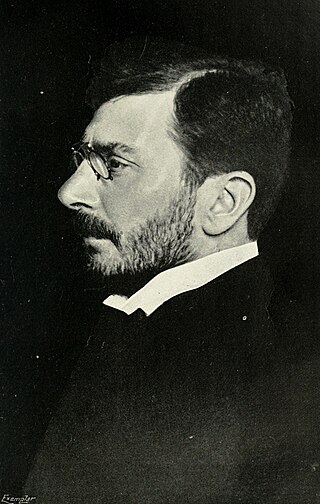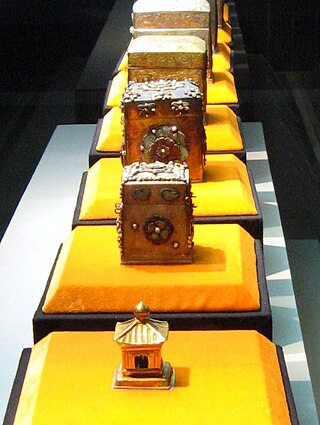
Ferdinand Vincent-de-Paul Marie Brunetière was a French writer and critic.

Éric Hollingsworth du Plessis is an author, translator and educator living in Virginia. He is a professor at Radford University, where he teaches writing in the Department of English.
Arthur Stuart Ahluwalia Stronge Gilbert was an English literary scholar and translator. Among his translations into English are works by Alexis de Tocqueville, Édouard Dujardin, André Malraux, Antoine de Saint-Exupéry, Georges Simenon, Jean Cocteau, Albert Camus, and Jean-Paul Sartre. He also assisted in the translation of James Joyce's Ulysses into French.
Albert Schinz was an American French and philosophical scholar, editor, and professor of French literature. Although he was born in Neuchâtel, Switzerland, Schinz died in the United States at an Iowa State University Hospital, in Iowa City, of pneumonia.

Paul Gustave Marie Camille Hazard, was a French professor and historian of ideas.

Chinese boxes are a set of boxes of graduated size, each fitting inside the next larger box.
Virginie Pivert de Senancour (1791–1876), the daughter of essayist Étienne Pivert de Senancour, was a French novelist and journalist. She served as her father's secretary and also wrote stories for children. Her work La Conquêtomanie is a satire against Napoleon. In Réplique à un mal avisé she responds to certain attacks levelled against her father by Eugène de Mirecourt. Nearly all the biographical information that exists about her father originates from her. One such biographical episode involves the novelist George Sand, who was influenced by Obermann. Eulalie writes that Sand, who tended to be tongue-tied with people she didn't know, sat facing the 63-year-old Senancour for 10 minutes without uttering a word before getting up and silently leaving the room.
The International Comparative Literature Association (ICLA) is an international organization for international research in comparative literature.

Jean Bessière is professor of Comparative Literature at the Sorbonne, and was educated at the École Normale Supérieure and holds a PhD from the Sorbonne as well as being agrégé in Modern Letters. He is the author of numerous books on Comparative Literature and is the president emeritus of the International Comparative Literature Association. His most recent works include La littérature et sa rhétorique, Quel statut pour la littérature ?, Principes de la theorie littéraire and Le roman contemporain ou la problématicité du monde. Jean Bessière has been on the faculty of numerous universities including Indiana University, Stanford, McGill and several French universities. In 2008 the Canadian Review of Comparative Literature dedicated an entire issue to him entitled: "Jean Bessière - Literature and Comparative Literature Revisited." Jean Bessière frequently lectures at universities throughout the world.
La Méprise (Marivaux) is a comedy in one act and in prose, written by French playwright Pierre de Marivaux and first performed on August 6, 1734, by the Comédie-Italienne at the théâtre of the Hôtel de Bourgogne.

L'Herbe à brûler is a Belgian novel by Conrad Detrez. It is the third volume of his "hallucinated autobiography" trilogy, following Ludo (1974) and Les plumes du coq. Published in 1978, it was awarded the Prix Renaudot the same year and is Detrez's best-known work. The novel is about a Roman Catholic from Belgium who, after years as a revolutionary in Brazil, returns to Europe and finds it enervated. It was first published in English by Harcourt Brace Jovanovich in 1984, translated by Lydia Davis.

Jeunes filles en serre chaude is a 1934 novel by the French author Jeanne Galzy. Its protagonists are young women at the École normale supérieure de jeunes filles in Sèvres, a suburb of Paris, at the time a girls-only school. The school, which Galzy herself attended, trained girls especially as teachers for the secondary education system. The background for the events in the novel is the 50th anniversary of the secondary school system for women; it is one of many French novels and other (autobiographical) texts of the period in which authors' school and university experiences were recounted.
André Vaillant, was a French linguist, philologist and grammarian who also specialized in Slavic languages.

Marie Anne Thérèse Ombline Desbassayns was a French planter and slave trader on the French island of La Réunion. She was one of the most prominent slave planters of the island after she was widowed in 1800 and until death, and played a significant role in the economy and slave industry of the colony. She became an important figure in the local folklore, and one of the most well-known figures of the history of the island.
Jacques du Tillet (1857–1942) was a French writer and critic. He published four novels. He was a theatre critic for the Revue politique et littéraire.
Jean Chaussivert was the professor of French at the University of New South Wales in the years 1973–91.
Canadian Review of Comparative Literature is a quarterly peer-reviewed academic journal of comparative literature. It was established in 1974 by the Canadian Comparative Literature Association. The journal primarily publishes articles in English and French, but occasionally accepts articles in German, Russian and Italian. The editor-in-chief is Irene Sywenky, the founding editor was M. V. Dimic' (1974-1998).
Marie Leblanc is a Mauritian writer, best known for her work as an editor of literary journals and other periodicals, as a novelist, and as a translator.
Father Setubal is a play by Maurice Maeterlinck dating probably to 1941 and first performed in that year in Lisbon. It is about a priest who hears the confession of a murderer who refuses to admit his crime publicly, after an innocent man has been condemned for it. In order to rescue the innocent without breaking the seal of confession, the priest accuses himself of the crime. The play was first published in Maeterlinck, Théatre Inédit in 1959..
Marguerite-Hélène Mahé was a French writer from Réunion, who is best known for her work Sortilèges créoles: Eudora ou l'île enchantée, published first in 1952, serialised into three issues of Revue des Deux Mondes. It was subsequently reissued whole, twice, in 1955 and 1985. It is a pivotal work in Reunionnais literature, due to its descriptions of the lives of those enslaved on the island. It was also the first novel by a Réunionese writer to use modernism and fantasy. She also wrote an autobiography, which is as yet unpublished.








